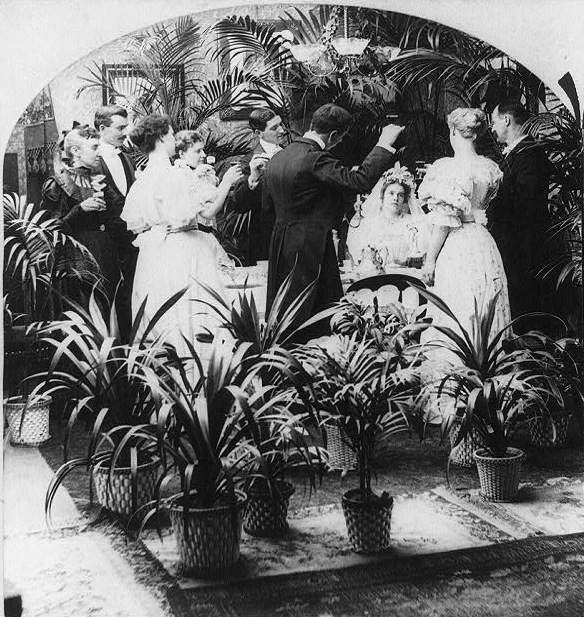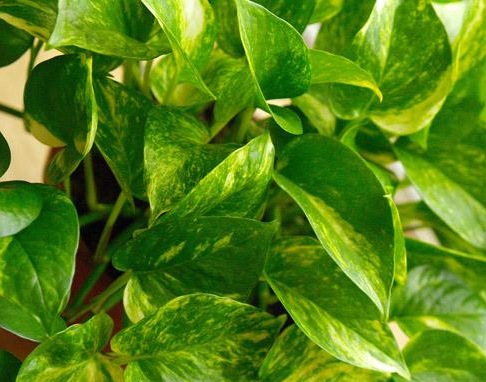
Victorian-era salon filled with houseplants. Photo Courtesy Library of Congress
By Kimberly Sevilla
Carbon dioxide, or CO2, levels are the highest they have been in MILLIONS of years. According to a recent article in the New York Times, “Heat-Trapping Gas Passes Milestone, Raising Fears” (May 10, 2013), the amount of the gas in the air is the highest it has been for at least three million years.
Rising levels of carbon dioxide is responsible for the often mocked Global Warming phenomenon and super storms such as Sandy and Irene. We all witnessed the devastation of our coastline here in New York, flooding buildings that are hundreds of years old. Scientists predict that there is more to come.
Ning Lin, a research scientist from Princeton University, summarized that a once-in-100-years storm brings a storm tide of 5 to 3 feet, and a once-in-500-years storm would bring a storm tide of 10.2 feet. Sandy’s storm tide was comparable to a 1,000-year hurricane. Predictions are that these types of storms could now happen as frequently as every three to 20 years.
It may seem like all hope is lost, that we are doomed. But I think, I know, that we can make a change, today.
I remember growing up near the Potomac River. The Potomac is 405 miles long and runs from West Virginia to Washington, D.C. It is one of the most important rivers in our nation’s history.
Growing up, I could smell the stench from the Potomac for miles; we would never consider fishing or swimming there; it was disgusting and dangerous. I was told at the time that the river was dying and that there was no hope; that people, sewage, and industrial waste had killed it. In 1972, the Clean Water Act had been passed and led to the construction of water treatment plants as well as controls on phosphorus and sewage in the water. Volunteer groups hosted “Clean Up” days with 110,000 volunteers, and today they have helped to remove nearly 6 million pounds of trash from the river.
Today, according to the Washington Post, the Potomac River is cleaner than it has been in decades, with conditions better than they were in the 1950s. Because of the efforts of individuals, along with legislatures, the river was saved. I have taken my children swimming and fishing in the Potomac, and that makes me very happy and hopeful. It’s something that, when I was a teenager, I never imagined I would do. We can save our air and ourselves as well.

Algae bloom from the Potomac in the 1980’s which has since been cleaned up.
CO2 is a naturally occurring gas that is made of one carbon molecule and two oxygen molecules. It is part of the carbon cycle and used by plants during photosynthesis. Plants use the carbon as a building block for their cells and release oxygen into the atmosphere.
Our levels of CO2 are high because we release too much of it through the burning of fossil fuels, the harvesting of peat bogs, industrial animal farming, and breathing. At the same time, we have reduced the amount of plant life on this planet through urban sprawl, deforestation, and industrial farming. Every breath a plant takes breathes in CO2 and breathes out oxygen. Every breath we take breathes in oxygen and breathes out CO2.
There are some things that we can do, every day, to improve our air quality; simply decrease the carbon output and increase the carbon intake and release of oxygen.
Most of us use public transportation to get to work. Here in New York, we have great choices, like Green Mountain Energy, to get electricity from sustainable, environmentally friendly sources. Hybrid and electric cars are a practical option for city dwellers. Bikes are a great option for reducing emissions. Switching from plastic bags to paper reduces the amount of plastic being used.
One place we may not have looked is in the garden. Peat moss is harvested from peat bogs in Canada, Ireland, and Finland. Peat bogs act as global coolers, absorbing carbon dioxide. When peat is harvested, tons of excess CO2 is released into the atmosphere. It takes thousands of years for peat moss to form, and after it is harvested, it will take thousands of years for it to be reclaimed.
Peat moss is used in most industrial garden soils, like Miracle-Gro. Miracle-Gro is also full of chemical fertilizers, polymers (plastic), herbicides, and pesticides. Not a place you would want to grow an edible plant, and stuff you probably don’t want to have in your house.
Switching from peat to alternatives like coconut husks, a by-product of the coconut industry, is a great way to reduce CO2. One of my favorite soil producers is Organic Mechanics. Their soil is made from coconut husks and a combination of organic materials like rice hulls (another byproduct), oat hulls, worm castings, and compost. They use biodiesel to power their equipment and package it in recycled plastic bags. It’s great soil and safe to use for edibles and in your home.
Choose wood, terracotta, or recycled plastic for your containers instead of plastic. This will help reduce the amount of plastic being used.
Plants are great air cleaners. Victorians who used coal (which releases a lot of CO2) to heat their urban homes also used lots of plants inside. Bringing back exoctic plants from worldwide travels was a popular Victorian hobby. Conservatories were added to homes to showcase the exotic treasures.

Golden pothos (Scindapsus aures)
A powerful plant for tackling formaldehyde. Photo Courtesy elvisripley/Flickr (www.mnn.com)
NASA, and particularly Bill Wolverton, have done a lot of studies on air cleaners and plants. One potted plant is enough to scrub 100 square feet, or one small New York City bedroom. Not only do plants take in excess CO2, they also clean toxins such as benzene, xylene, toluene, formaldehyde, and trichloroethylene. They clean the air and help to regulate humidity, making us feel more comfortable on hot days and less reliant on air conditioning. It is NASA’s recommendation that we use 15 to 18 plants in 6- to 8-inch pots to clean a 1,800-square-foot home.
All plants will clean the air and release oxygen. Here are the top 10, according to NASA:
1. Heartleaf philodendron (Philodendron scandens “oxycardium”). A medium sized plant that releases moisture into the air. It is an easy plant and enjoys part sun and temperatures of 65 to 75 degrees.
2. Lady Palm (Rhapsis excelsa). This is a slow growing, easy plant that resists pests and enjoys partial sun.
3. Bamboo Palm (Chamaedorea seifrizii). This palm can grow up to 6 feet high and is more effective than the areca and lady palm at removing airborne toxins. It does enjoy a brighter light.
4. Rubber Plant (Ficus Robusta). The rubber plant can tolerate lower indoor temperatures and is great at removing formaldehyde. This is a must for people who are exposed to cigarette smoke or people that live in new construction.
5. Draceana “Janet Craig” (Draceana deremensis “Janet Craig”). Also known as the Corn Plant, this is a leafy green plant that is great at removing trichloroethylene from the air. This chemical is emitted by photocopiers and drycleaning. It lives in partial sun and is a great plant for offices.
6. English ivy (Hedera helix). English Ivy is a vining plant that removes formaldehyde from the air. It would enjoy some time outside in late spring and early fall, as it likes a little cooler temperatures at night (50 to 60 degrees).
7. Dwarf date palm (Phoenix roebelenii). A cousin of the Middle Eastern date palm, this dwarf variety grows up to 6 feet tall. It thrives without much light and can survive for decades. It is great at removing xylene, which is a byproduct of caulk, adhesives, paint, and particle board (Ikea furniture). It is a great plant for someone who has recently remodeled, lives in new construction, or has a lot of new furniture.
8. Ficus benjamina (Ficus benjamina). The ficus is a versatile plant that can be shaped as a bush or tree. It is one of my favorite plants. They do have a habit of shedding their leaves until they adapt to a new space. But once settled, they will last for years and are very easy to care for.
9. Boston Fern (Nephrolepis exaltata “Bostoniensis”). This fern has lush, green fronds and can be placed on a table or in a hanging basket. It is great at removing chemicals and humidifying but needs a little more attention. This is one plant that LOVES to be misted and talked to; a great substitute for a pet.
10. Peace lily (Spathiphyllum sp.). This plant is one of the few that are easy to bloom indoors. It is easy to care for and very adaptable to different situations.
Also in the top 20 are the Spider Plant, Golden Pothos, Chinese Evergreen, Snake Plant, Red-Edged Dracaena (Dracaena marginata), Dracaena Warneckii, and the Elephant Ear Philodendron.
Even more hopeful to me is the phenomenon of rooftop planting and of growing on vertical surfaces. Invented by the ancient Babylonians (those hanging gardens) and perfected by Patric Blanc, vertical gardening is an excellent way to bring more green to the city. By using our horizontal surfaces (roofs) and vertical surfaces (walls), we can potentially create MORE plant life that would have existed in the past. Much like how our lungs work (again, with the O2/CO2 exchange), increasing the surface area covered with plants will increase the possibility of O2 emissions, while increasing CO2 consumption, reversing the trend that we now have.
There are lots of terrific options for vertical and wall planters. My favorite is the Ella Wall pot, which is a selfwatering planter made of recycled plastic. It’s attractive, easy to install, and it won’t drip on your walls or your furniture. And it looks great in groupings.
I am hopeful and positive that through individual effort, and innovation, we can change the world and the air we breathe.
Kimberly Sevilla
Owner
Rose Red & Lavender
Flowers, Plants and Beautiful Things
653 Metropolitan Avenue
Brooklyn, NY 11211
www.roseredandlavender.com
Leave a Reply